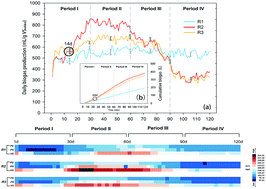Anaerobic co-digestion of municipal wastewater sludge with food waste with different fat, oil, and grease contents: study of reactor performance and extracellular polymeric substances†
Abstract
The linkage between reactor performance and microbial extracellular polymeric substances (EPS) was investigated in three groups of semi-continuous mesophilic anaerobic co-digestion (ACoD) systems, treating municipal waste sludge (MWS) with food waste (FW) with different fat, oil and grease (FOG) contents. The addition of FOG to the test reactors enhanced the co-digestion process significantly in terms of reactor performance and microbial activity. During the process, no major variations in pH and VFA/Alk were observed. Moreover, the daily yield of biogas peaked at 810.3 mL per g VSadded when the FOG load reached 42% of volatile solids (VS), with an organic loading rate (OLR) of 5.2 g VS L−1 d−1 and a hydraulic retention time (HRT) of 20 days. However, an excessive FOG load (55% of VS) reduced biogas production by 40.3% when compared with the control unit (539.3 mL per g VSadded). At the end of digestion, 195 L, 381 L and 351 L cumulative biogas were obtained in the three systems, respectively. Further analysis of extracellular polymeric substances (EPS) showed that the accumulation peaked at 648.5, 772.3 and 640.9 mg L−1 with the optimal digestion parameters, respectively. The proportion of LB-EPS was always less than that of TB-EPS, which accounted for about 40% and 60%. The FOG-enhanced systems (R2 and R3) produced considerably higher levels of EPS than the control system (R1) for both humic acid substances (HS) and proteins (PN). Moreover, variations in EPS revealed that the three systems experienced an accommodation phase followed by a vigorous phase and an exhausted phase with elevated levels of added FOG. However, enhanced units may undergo exhaustion prematurely due to “doping” phenomena.


 Please wait while we load your content...
Please wait while we load your content...